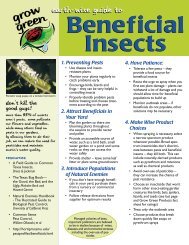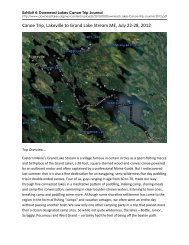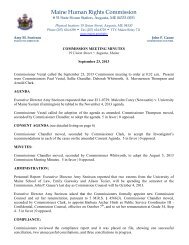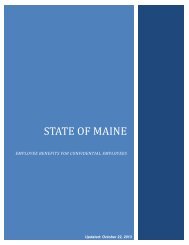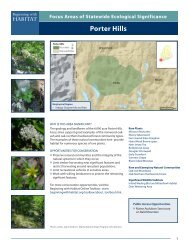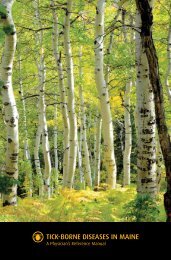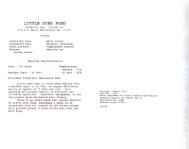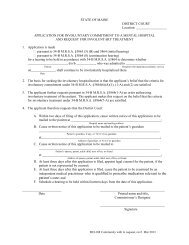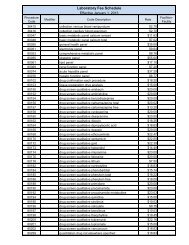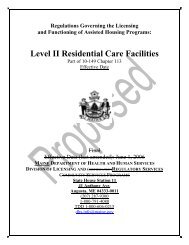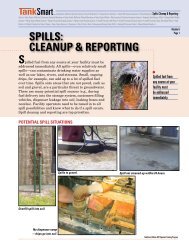Fact Sheet: Hemlock Woolly Adelgid - Maine.gov
Fact Sheet: Hemlock Woolly Adelgid - Maine.gov
Fact Sheet: Hemlock Woolly Adelgid - Maine.gov
Create successful ePaper yourself
Turn your PDF publications into a flip-book with our unique Google optimized e-Paper software.
Introduction: The hemlock<br />
woolly adelgid (HWA) is a<br />
destructive introduced pest of forest<br />
and ornamental hemlock trees<br />
(Tsuga spp.) in the eastern United<br />
States. The adelgid feeds at the<br />
bases of needles, causing them to<br />
desiccate and the tree to take on a<br />
gray cast. The result is needle loss,<br />
which prevents trees from producing<br />
new apical buds. Heavy infestations<br />
have killed trees in as little as 4<br />
years, yet some trees have survived<br />
infestations for more than 10 years.<br />
Other stress factors may affect the<br />
tolerance of Tsuga spp. to insect<br />
attack.<br />
HWA is native to Japan and<br />
possibly China where it is a<br />
<strong>Hemlock</strong> <strong>Woolly</strong> <strong>Adelgid</strong><br />
Adelges tsugae Annand<br />
Figure 1. Characteristic white ovisacs of hemlock woolly adelgid.<br />
(Michael Montgomery, USDA Forest Service, www.Bugwood.org)<br />
common, but innocuous inhabitant of forest and ornamental hemlock (Tsuga diversifolia Masters and T.<br />
sieboldii Carriere) and spruce (probably Picea jezoensis hondoensis [Sieb. & Zucc] and P. polita [Carriere]).<br />
HWA occasionally attains high densities on hemlock in Japan, but only on ornamental trees that are growing on<br />
very poor sites. However, even under these circumstances, Japanese hemlocks are not significantly injured,<br />
because of host resistance and several arthropod predators that are believed to help regulate HWA.<br />
HWA was first observed in Western North America in the early 1920’s in British Columbia and in eastern<br />
North America some 30 years later in Virginia. Although the details of these earlier infestations are unknown,<br />
they undoubtedly resulted from accidental introductions from Asia. The first sample of HWA submitted to the<br />
Insect and Plant Disease Diagnostic Laboratory at Cornell Cooperative Extension – Suffolk County was in<br />
November 1985. Since then this insect has become a significant problem on Long Island.<br />
Hosts and Potential for Spread: In eastern North America, HWA is a destructive pest of eastern<br />
hemlock (T. canadensis (L.)) and Carolina hemlock (T. caroliniana Engelm.). These hemlock species have<br />
shown little or no resistance to HWA attack, and many trees growing under a wide variety of natural and<br />
ornamental conditions have died. Currently, HWA occupies a small part of eastern hemlock’s natural range.<br />
However, during the last decade it has spread at a rate of about 20 to 30 km each year and its population levels<br />
have increased dramatically. Wind, birds, deer, and humans help spread HWA throughout the Northeast.<br />
Because HWA is adapted to high elevations in Japan where winter temperatures commonly drop below –35° C<br />
(-63°F), it should continue to spread in eastern North America until it occupies the entire range of eastern<br />
hemlock.<br />
Cornell Cooperative Extension in Suffolk County provides equal program and employment opportunities.
Life Cycle of <strong>Hemlock</strong><br />
<strong>Woolly</strong> <strong>Adelgid</strong><br />
HWA has a complex life cycle<br />
that may involve both hemlock<br />
and spruce (Picea spp.) as<br />
hosts. In North America<br />
including Long Island HWA<br />
has three generations that<br />
develop each year on hemlock.<br />
Two generations develop<br />
simultaneously in the spring.<br />
These are called sexuparae,<br />
which contain wings and<br />
progrediens, which do not<br />
contain wings. The sexuparae<br />
adults will leave the hemlock<br />
in search of a spruce on which<br />
to oviposit (lay their eggs).<br />
Their progeny (offspring) are<br />
called sexuales, and the<br />
sexuales generation has not<br />
been observed to develop successfully on any spruce species in North America. Those that leave hemlock in<br />
search of a suitable spruce presumably die. The few that remain on hemlock will also die without laying eggs.<br />
Progrediens progeny are called sistens. The sistens generation develops (on hemlock) during autumn and<br />
winter, following a summer aestivation (passing the summer in a dormant state) period.<br />
The seasonal development of HWA on hemlock in Connecticut is characterized by overlapping life stages.<br />
Seasonal development on Long Island would<br />
be similar. Most sistens mature into adults in<br />
February, and from March through May each<br />
sisten will produce a single white ovisac, which<br />
can contain up to 300 eggs. The white ovisacs<br />
(see Figure 1. and Figure 2.) are very apparent<br />
and provide an easy way to identify hemlock,<br />
which are infested with HWA. Nymphs of both<br />
types (sexuparae and progrediens) begin<br />
hatching from these eggs in April. These<br />
nymphs are referred to as crawlers and search<br />
for a suitable site to settle and feed. This<br />
feeding site will always be at the base of a<br />
needle. The insect will deplete food reserves<br />
from the tree’s storage cells via a long stylet<br />
(mouthpart). The nymphs quickly develop<br />
through four instars (molts) and mature (into<br />
sexuparae and progrediens) in June. Progredien<br />
adults will remain on hemlock and sexuparae<br />
Life Cycle of <strong>Hemlock</strong> <strong>Woolly</strong> <strong>Adelgid</strong><br />
(<strong>Hemlock</strong> <strong>Woolly</strong> <strong>Adelgid</strong>. USDA Forest Service. FHTET-2001-03<br />
March 2001<br />
Figure 2. Close-up of white ovisacs. (Chris Evans, River to<br />
River CWMA, www.Bugwood.org)<br />
adults leave hemlock in search of a suitable spruce. Progredien adults produce the characteristic white cottony<br />
ovisacs (see Figure 3.) during June and July. Sexuparaes as earlier stated presumably die without finding a<br />
suitable spruce. Sisten crawlers hatch from the eggs produced in June and July and settle at the base of a<br />
(hemlock) needle where they feed for a few days. After feeding for this short period of time they will enter the<br />
summer aestivation period where they remain until October. In October these nymphs resume development and
will mature into sisten adults by early February. These adults<br />
will oviposit their eggs from March through May, which is the<br />
beginning of a new generation of HWA.<br />
Impact on <strong>Hemlock</strong>: Feeding by HWA causes the needles<br />
on infested branches to dessicate, turn grayish-green color,<br />
and then drop from the tree, sometimes within months. Most<br />
buds on infested branches are also killed as a result of feeding<br />
so little if any new growth is produced on these branches.<br />
Dieback of major limbs can occur within two years and<br />
progresses from the bottom of the tree upward, even though<br />
the infestation may be evenly distributed throughout the tree.<br />
Trees may die within four years, but as some homeowners<br />
have seen, some may survive longer with only a sparse<br />
amount of foliage at the very top of the tree. There is some<br />
evidence that some trees weakened by a HWA infestation may<br />
recover, although the factors that lead to such recovery are not<br />
well understood.<br />
Management Options in Landscapes: <strong>Hemlock</strong>s<br />
infested with HWA can be kept healthy in a landscaped setting<br />
by using an integrated management approach that includes:<br />
Taking care when moving plants, logs, firewood, or bark<br />
chips from infested to uninfested areas, especially from<br />
March through June when adelgid eggs and crawlers are abundant.<br />
Figure 3. Close-up of adult (black) HWA<br />
and eggs (orange) inside an ovisac (Michael<br />
Montgomery, USDA Forest Service,<br />
www.Bugwood.org)<br />
Water hemlocks during periods of drought. On Long Island in most seasons the critical months for watering<br />
established hemlock are June, July and August. Deep watering rather than frequent, shallow watering is<br />
recommended. Prune off all dead and dying branches. Although HWA is capable of killing hemlock<br />
growing in seemingly optimal condition those trees experiencing stress from drought and other factors<br />
succumb to adelgid attack more quickly.<br />
Fertilizing hemlock trees after HWA has been completely controlled can help encourage growth and<br />
stimulate recovery. Fertilizing infested hemlocks with nitrogen enhances HWA survival and reproduction.<br />
Therefore, nitrogen fertilizer should not be applied to infested hemlock.<br />
If you need to replace dead hemlock consider using Western species (Tsuga mertensiana (Bong.) (Carr.) or<br />
T. heterophylla (Raf.) (Sarg.)). You may also refer to Pest Resistant Hedges and Screens for Privacy for<br />
more suggestions. This list is available from Cornell Cooperative Extension – Suffolk County for a slight<br />
charge.<br />
Applying chemical insecticides is an essential component of any integrated approach to managing<br />
populations of HWA. Even if you follow all of the measures described above, infested trees are usually<br />
unable to survive for more than a few years if chemical insecticides are not used to control the infestation.<br />
It is necessary to thoroughly drench infested trees with a recommended insecticide to achieve effective results.<br />
Be sure to spray trees from top to bottom as well as on all sides. Homeowners should hire certified pesticide<br />
applicators that have the proper equipment if the trees are too tall or many trees need to be treated. Two spray<br />
treatments each year are usually necessary if a hemlock tree has a HWA infestation.<br />
Insecticide treatments suggested to homeowners: At the dormant stage (late April to early May), apply<br />
horticultural oil. In late June or late September and the following year in early June, treat with insecticidal soap.<br />
Thorough coverage with oil or soap is necessary.
Certified pesticide applicators should refer to a<br />
current copy of Pest Management Guidelines for<br />
Commercial Production and Maintenance of<br />
Trees and Shrubs for insecticide<br />
recommendations. Copies of this publication are<br />
available from Cornell Cooperative Extension –<br />
Suffolk County.<br />
Certified pesticide applicators have the option of<br />
applying certain systemic insecticides into the<br />
roots of infested hemlock trees as an alternative<br />
to foliar sprays to protect trees that can not be<br />
sprayed thoroughly. Such an insecticide is taken<br />
up by the roots and distributed through the tree<br />
where it can control HWA for several months.<br />
However, trees must have a healthy sap flow for<br />
these soil techniques to be effective. It is<br />
recommended that certified pesticide applicators<br />
refer to a current copy of Pest Management Guidelines for Commercial Production and Maintenance of Trees<br />
and Shrubs for such insecticide recommendations. In addition those applicators should follow the<br />
recommendations outlined in the Best Management Practices for Long Island, New York Arboricultural Uses<br />
for such soil treatments (copies are available from Cornell Cooperative Extension – Suffolk County or visit the<br />
CCE web site http://ccesuffolk.org/best-management-practices-for-long-island-ny/<br />
There are several native species of insects that are occasional predators of HWA in North America.<br />
Unfortunately none of these predators has had a significant impact on adelgid populations or has shown much<br />
potential for biological control. For this reason the focus is on introduced predators and the coccinellid or lady<br />
beetle (Pseudoscymnus tsugae Sasaji and McClure n. sp.) shows the most promise. Both the larvae and adults<br />
actively prey on all stages of HWA on hemlock branches. Three lady beetles in the genus Scymnus, (Figure 4.)<br />
which have been imported from China, prefer to feed on HWA eggs, but will feed on other life stages as well.<br />
So far P. tsugae is the only non-native predator that has been released into the environment and results have<br />
been encouraging<br />
Information obtained from <strong>Hemlock</strong> <strong>Woolly</strong> <strong>Adelgid</strong>. Mark S. McClure, Scott M. Salom and Kathleen S.<br />
Shields. USDA Forest Service. FHTET-2001-03 March 2001.<br />
Pesticide recommendations obtained from Part II Guide to Pest Management around the Home – 2009-2010<br />
Pesticide Guidelines, Cornell Misc. Bulletin S74II. Copies of this publication are available from Cornell<br />
Cooperative Extension – Suffolk County.<br />
The Pesticide Management Education Program (PMEP), in cooperation with the New York State Department of<br />
Environmental Conservation (NYSDEC), maintains a web site with a searchable database for pesticide products<br />
currently registered in New York State. Individuals who have Internet access can locate currently registered<br />
products containing the active ingredients suggested above at http://pmep.cce.cornell.edu/pims/current (NYS<br />
PIMS).<br />
This publication contains pesticide recommendations. Changes in pesticide regulations occur constantly<br />
and human errors are still possible. Some materials mentioned may no longer be available, and some uses<br />
may no longer be legal. All pesticides distributed, sold or applied in New York State must be registered<br />
with the New York State Department of Environmental Conservation (NYSDEC). Questions concerning<br />
the legality and/or registration status for pesticide use in New York State should be directed to the<br />
appropriate Cornell Cooperative Extension Specialist or your regional NYSDEC office. Read the label<br />
before applying any pesticide.<br />
TK: 1/2010<br />
Figure 4. Scymnus suturalis Thunberg adult on hemlock<br />
twig. (Suzanne Lyon, University of Massachusetts,<br />
www.Bugwood.org)



